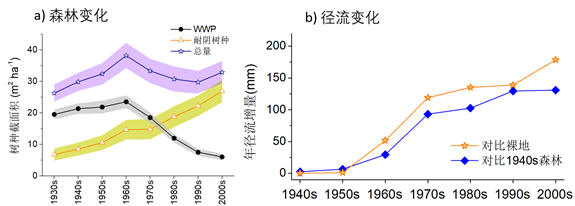In the Anthropocene, human activities have changed the face of the earth, and the structure and function of forests have also been greatly affected. For example, in northern Idaho, the once widespread Western White Pine (WWP; Pinus monticola Dougl.) has almost died out due to human logging, wildfires, and rust from the timber trade. Its distribution area dropped sharply from about 8000km2 in 1900 to 47km2 in 1992. This tree is highly productive and also very water consuming. When WWPs die, they are replaced by shade-tolerant species that are less productive but less water-intensive. Such large-scale tree death should cause huge changes in the water cycle in forest ecosystems, but such changes are difficult to calculate accurately in the context of human activities and climate change, and the effects of various factors are difficult to distinguish. Furthermore, these changes often precede scientific observations by humans, and the lack of long-term historical data limits research.
Professor Wei Liang in the laboratory and more than ten foreign collaborators conducted research on the impact of multiple factors on the forest water cycle. The study works using rare long-term data in an experimental forest established in 1911, combining hydrological modeling with observations of runoff (since 1938), meteorology (since 1911), snow cover (since 1936), and vegetation observations (the 1920s onwards), thereby quantitatively determining the impact of various anthropogenic and non-anthropogenic factors on the water cycle. With the gradual death of the WWP, the annual runoff in the region has increased by 30-40% in the six or seven decades since 1939, but how can the effects of multiple factors such as the death of the WWP, the growth of new forests, climate change, and deforestation be distinguished? After that, the study used a model to reproduce the scenario of historical changes in vegetation and simulated changes in factors such as runoff, evapotranspiration, and snow cover, and finally distinguished various possible impacts. The study found that the impact of changes in tree species accounted for only 1/3 of the change in the runoff, while small-scale logging by humans could explain 2/3 of the change in runoff; climate change contributed less to the change in the runoff. This study provides an example of how to distinguish the effects of various interacting factors on the forest water cycle over long time scales.
The research results, titled "White pine blister rust, logging, and species replacement increased streamflow in a montane watershed in the northern Rockies, USA", were published in the Journal of Hydrology, a high-level journal in the field of hydrology. Professor Wei Liang from the laboratory was the first One and the corresponding author. This project is funded by the major project of the China Natural Science Foundation of China "The Impact and Adaptation of Human Activities in the Anthropocene" (41991254) and the general project "Using tree ring data to improve forest simulation in long-term climate change" (1971492).
Article link:https://www.sciencedirect.com/science/article/pii/S0022169422008022

Figure 1: Changes in tree species (a) and changes in runoff (b) in the study area